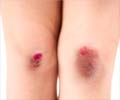About
Bleeding disorder is an acquired or an inherited condition, which is characterized by excessive bleeding in the persons affected by the disorder.
In our body, blood circulates inside the blood vessels called the veins, arteries and capillaries. If there is a crack or damage of the vessel then bleeding occurs into the organs or externally.

Under normal conditions, our body resorts to its own mechanism to cope with bleeding through a process called hemostasis. During this process the blood vessels constrict to decrease blood flow and platelets in the blood accumulate to form a plug. This is then stabilized by a film of fibrin that forms a barrier. This barrier remains in place till the injury is fully healed.
The process of clot formation, involving a range of clotting factors, occurs sequentially in a coagulation ‘cascade’. The clot is dissolved (fibrinolysis) once the wound is healed.
In people with bleeding disorders, the clotting process is impaired and this results in spontaneous bleeding. If a component that aids in clotting is missing, deficient or is dysfunctional then it results in excessive bleeding.
The disorders are first detected during early childhood and the resultant bleeding can be very severe.
Bleeding conditions do not have a permanent cure. They can, however, be managed.

















